
Text and photo images
©2013 Richard Leonard.

The Rutland Railroad occupies an important place in our family history. Rutland, Vermont, was the home town of my paternal grandparents, Don M. and Julia Day Leonard. Don's maternal grandfather, Luther Angier, had been employed in the car shops of one of the Rutland Railroad's predecessor companies. Even after they lived in Newtonville, Massachusetts, my grandparents summered on Lake Champlain at Thompson's Point, Vermont, which they reached on the Rutland via a connection with the Boston & Maine — although it was said that Don and Julia sometimes sent my father and my uncle by train and drove up to Vermont in their Stanley Steamer.
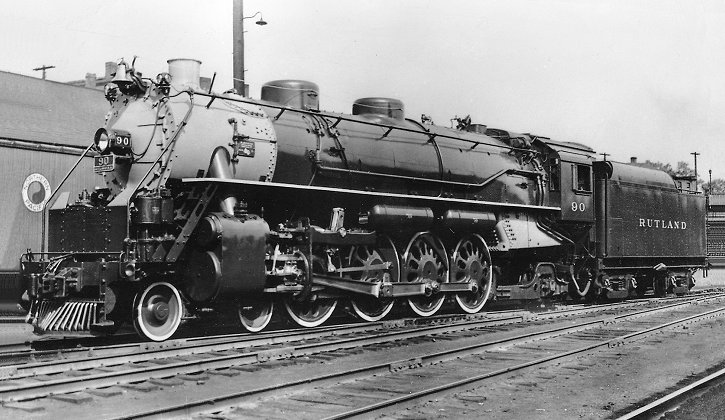
My father, Richard D. Leonard, began his ministry as a small-town Vermont pastor. While serving at Grand Isle, Vermont, he commuted to the United Theological College in Montreal via the Rutland and its Canadian National connection. Dad was familiar with the Rutland roster, which included a number of ex-New York Central engines. From one of his residences on Grand Isle he could see the passing trains and even read the engine numbers.
After World War II the Rutland needed new power to augment its aging stable. Always strapped for cash, the company could not yet afford diesels so it ordered four 4-8-2s from the American Locomotive Company which were delivered in June 1946. Of modest dimensions to suit the Rutland's infrastructure, Nos. 90-93 were nevertheless, in my opinion, one of the most handsome and well-proportioned modern steam designs. 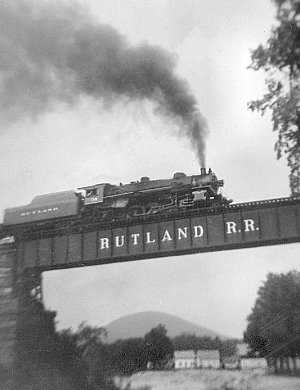 With 230 pounds per square inch of boiler pressure, they rolled on 73-inch disc drivers powered by 26x30-inch cylinders, and put out 54,300 pounds of tractive effort. Their small tender held 11,000 gallons of water and 14 tons of coal, quite sufficient for the Rutland's short runs. Painted green, these locomotives were a favorite with the Rutland's crews who dubbed them the "Green Hornets." They handled both freight manifests and passenger trains such as the Green Mountain Flyer.
With 230 pounds per square inch of boiler pressure, they rolled on 73-inch disc drivers powered by 26x30-inch cylinders, and put out 54,300 pounds of tractive effort. Their small tender held 11,000 gallons of water and 14 tons of coal, quite sufficient for the Rutland's short runs. Painted green, these locomotives were a favorite with the Rutland's crews who dubbed them the "Green Hornets." They handled both freight manifests and passenger trains such as the Green Mountain Flyer.
I can't take credit for the above picture of No. 90; I scanned it from a railroad publicity photo on a post card. But I did see one of these engines in Rutland during a family trip from Michigan to New England, probably in 1950, and remember the scene well. With dieselization, these fine engines were withdrawn from service around 1953 and offered for sale. Regrettably no buyers appeared, and they were scrapped in 1955. The Rutland line itself later fell victim to labor disputes. Happily, most portions in Vermont are still operated by the Vermont Railway and the Green Mountain Railroad.
Sometime in the early 1930s my father snapped the photo at left of one of the Rutland's class H-6 Mikado types on a bridge. Viewer Jim Dufour has identified the location as East Wallingford, Vermont, on the line to Bellows Falls. These 2-8-2s, numbered 32-37, were 1918 products of American Locomotive Company's Schenectady works, following the light U.S.R.A. design. They had 63-inch drivers, carried 200 pounds per square inch of boiler pressure, and had cylinder dimensions of 26x30 inches. With a locomotive weight of 264,000 pounds and a grate area of 67 square feet, they developed 54,700 pounds of tractive effort and were the railroad's mainstays for heavy freight service until dieselization.
Before the arrival of the "Green Hornets," passenger service on the Rutland was in the hands of 4-6-0s and six 4-6-2s in classes K-1 and K-2 numbered 80-85. The K-1 class was built by ALCo in 1925, with 69-inch drivers, 200 pounds of boiler pressure, and 25x28-inch cylinders. They weighed 278,000 pounds and exerted a tractive force of 43,100 pounds. The photo below of K-1 No. 81 shows the class as modernized with the one-piece cast rear truck. It must have been taken by my father, possibly at the Bonaventure station in Montreal during one of his trips to attend classes on the McGill University campus.
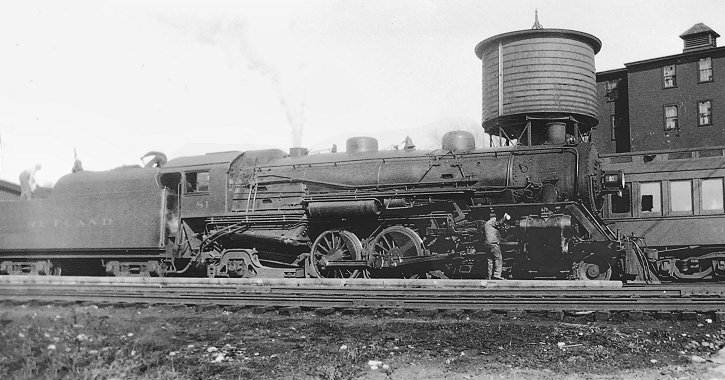
I found this photo of Boston & Maine 4-6-2 No. 3653 in my father's collection of steam photos and, since it was much older than most of the others I assume it was taken by him and qualifies for inclusion in this archive. Like the images below, it doesn't belong to the 1950s era. In this case the picture was probably snapped around 1930 after Dad had acquired his Kodak folding cartridge camera that used size 116 film. The locomotive displays the paint scheme that was applied to B&M engines from 1911 to at least 1928. My guess, based on the hill in the background and the sun angle, is that the photo was taken at White River Junction, Vermont. My father's earlier ministry was in northern Vermont, and he may have transferred here to a Central Vermont train upon returning from a visit to my grandparents' home in Newtonville, Massachusetts.
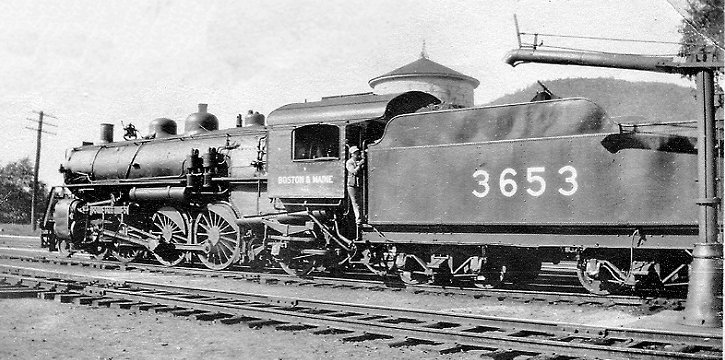
No. 3653 belonged to the Boston & Maine's class P-2-d, erected by ALCo in 1911. She had 73-inch drivers, 22x28-inch cylinders, and a boiler pressure of 200 pounds per square inch. With these specifications she would have developed a tractive effort of about 32,000 pounds, and her locomotive weight was 247,700 pounds. Engines of this class ended their days in Boston commuter service, and may be seen in the Green Frog video The Boston and Maine. No. 3653 was retired in 1953, and all members of the class by 1956. I am indebted for some of these details to James B. VanBokkelen's Unofficial Boston & Maine Railroad Page.
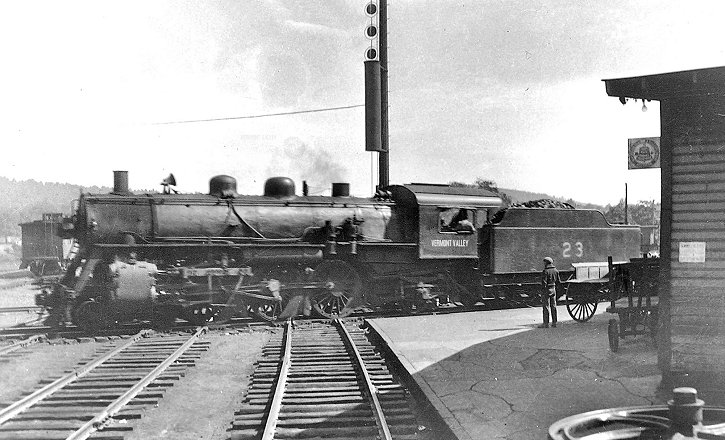
Another discovery in my father's collection was negative for the photo above, showing Vermont Valley Railroad 4-6-2 No. 23. She appears to be a sister locomotive of the B&M engine above. Into the 1920s the Boston & Maine's Connecticut River line included two predecessor railroads, the Vermont Valley Railroad on the Vermont side and the Sullivan County Railroad on the New Hampshire side. Each of them was assigned its own small roster of engines from the B&M stable. This photo by my father is of interest because it shows the old ball signal suspended from the pole behind the engine, guarding the crossing. The location is Bellows Falls, Vermont, where the Boston & Maine line from Boston, through southwestern New Hampshire, met the Connecticut River line and the Rutland Railroad. The "Vermont Valley" engine is heading north. Dad evidently took the photo from the rear platform of a train (note the brake wheel in the lower right corner), either one he had arrived on from Boston or a Rutland Railroad train that would take him, perhaps, to my grandparents' summer camp at Thompson's Point on Lake Champlain, near Charlotte. (It may have been a through train via both railroads.) Viewer Bill Keay reports that Vermont Valley No. 23 was renumbered to B&M 3648 in 1926, which establishes a date in the mid-1920s for this photo; she was scrapped in 1955.
While studying at Boston University in the 1960s I served for two years as pastor of a Methodist church in North Charlestown, New Hampshire. My weekly travels often took me through Keene, where I encountered "Monadnock Northern" 2-8-0 No. 15 operating in tourist service for F. Nelson Blount's Steamtown. Built by Baldwin in 1916 as No. 20 of the Oneida & Western short line in Tennessee, this engine was sold in 1937 to the Rahway Valley Railroad of New Jersey where it operated until 1953. In 1959 Mr. Blount acquired No. 15 for his Steamtown operation, which for a time ran excursions over former Boston & Maine trackage between Keene and North Walpole, New Hampshire under the name Monadnock Northern (from the famous Mount Monadnock, near Keene). For another view of No. 15 at Keene in our Random Steam Photo Collection, click here.
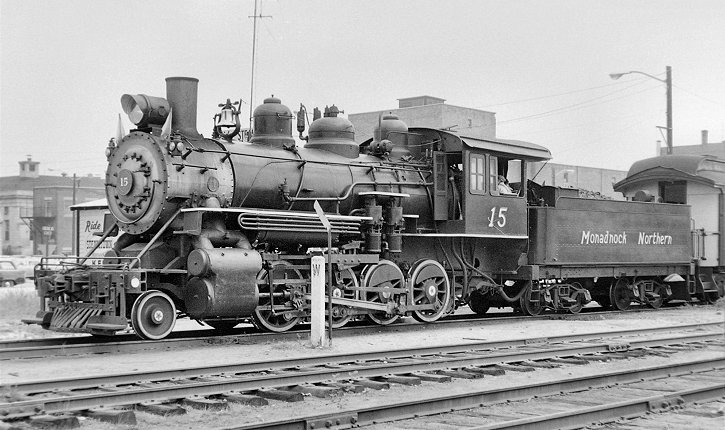
Oneida & Western No. 20 originally had slide valves, but was rebuilt by Baldwin with piston valves in a rare outside-admission arrangement — notice the two pipes, instead of the usual central pipe, extending from the top of the valve chamber. Also notice the "indirect " or "reverse" position of the eccentric crank, angled toward the rear of the locomotive, and the radius bar connected to the combination lever below the valve stem instead of above it. After being acquired by Steamtown the locomotive operated for five years. Currently she is stored inoperable at the Steamtown National Historic Site, her appearance altered by installation of a new headlight centered on the smokebox. No. 15 appears briefly in the Green Frog video The Boston and Maine.
In 1965, F. Nelson Blount's Steamtown museum — which had moved to Bellows Falls, Vermont — took over operation of the former Rutland Railroad line between Bellows Falls and Rutland, known then as the Green Mountain Railroad. Steam-powered tourist service operated at the southern end where, at Chester, Vermont, I took this transparency of 2-6-0 (Mogul) type No. 89 in September 1968. (For another view in our Random Steam Photo Collection, click here.) Built in 1910 by the Canadian Locomotive Company for the Grand Trunk Railway, this engine became Canadian National No. 911, in class E-10-a, in 1923. These locomotives had 21x26-inch cylinders, 63-inch drivers and a boiler pressure of 170 pounds. They exerted 26,000 pounds of tractive effort and weighed 141,800 pounds.
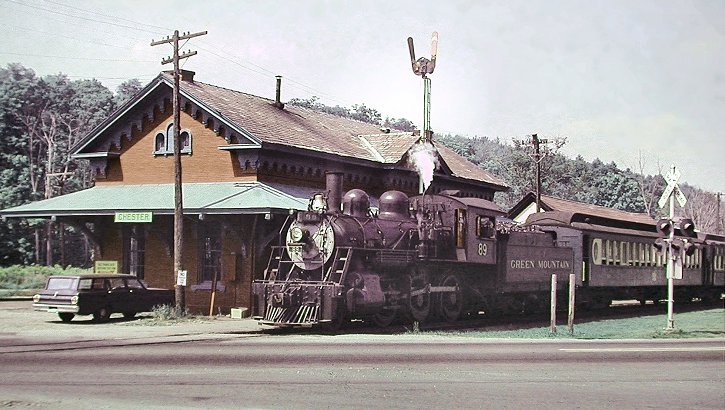
After the death of Mr. Blount in an airplane crash, the Green Mountain Railroad became independent of the Steamtown organization and continues as a common carrier under the State of Vermont. No. 89 was sold to the Strasburg Railroad in Pennsylvania. The Steamtown collection was moved to the Steamtown National Historic Site in Scranton, Pennsylvania, under the National Park Service, in 1984.
Said to be the last two-foot gauge steam engine built for service in the United States, this 2-4-4T locomotive was built by Baldwin in 1924 for the Bridgton & Saco River (later Bridgton & Harrison) two-foot gauge railroad in Maine. By World War II the Maine two-footers were out of business. In 1946 and 1947, Ellis D. Atwood bought most of the remaining equipment and had it moved to South Carver, Massachusetts. There the 38-ton No. 8 and other locomotives did double duty hauling passengers for Atwood's Edaville Railroad family theme park and providing transportation for his cranberry bogs over the Edaville's five-and-one-half mile loop.
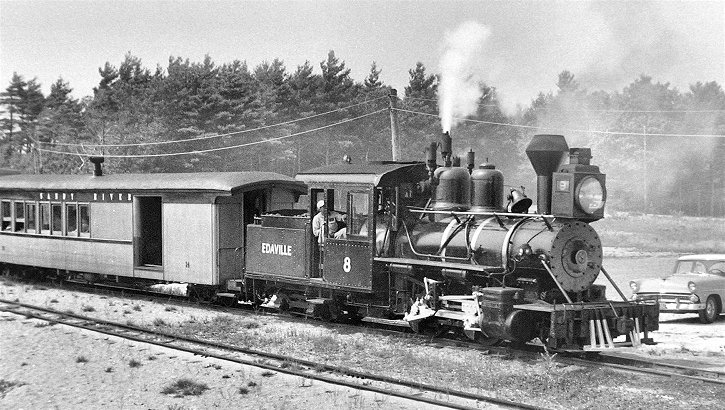
In September 1960, on a family trip to New England to bring me to Boston University School of Theology where I was to begin my studies for the ministry, we rode the Edaville train. I photographed No. 8 in service that day — complete with fake antique headlight and balloon stack — along with other railroad equipment on static display there. With the demise of the Edaville operation much of the narrow gauge equipment was returned to Maine in 1993. Today No. 8, restored to her original appearance and relettered for her first owner, is in service at the Maine Narrow Gauge Railroad Company & Museum in Portland. For another view of this engine in our Random Steam Photo Collection, click here.
The same trip took our family to the Mount Washington Cog Railway in New Hampshire. Because of the weather on that rainy August 1960 day we did not take the ride up the mountain. However, I photographed my parents, Dr. R. D. and Katheryn C. Leonard, standing next to the "Cog's" No. 1, named Mt. Washington. The three-mile line, which remains a popular tourist attraction, uses a rack-and-pinion system to gain traction as locomotives push a car up the slope almost to Mount Washington's 6288-foot-high peak.
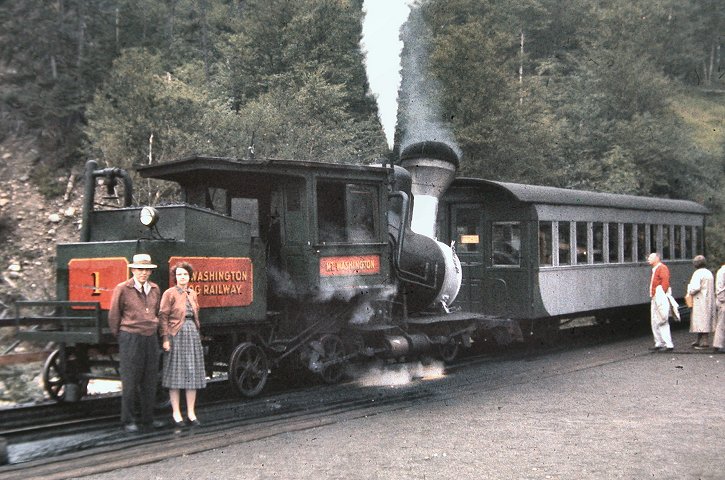
This locomotive was built in 1883 by Manchester Locomotive Works and was first named Falcon as No. 7. It was renumbered when rebuilt after being damaged in a fire in 1895, and in 1931 it received the name Mt. Washington. The Mount Washington steam locomotives display a variety of configurations, this example having the boiler angled, which keeps it horizontal while climbing the mountain, but having the cab parallel to the track instead. Currently No. 1 is stored out of operation, since the Cog Railway now operates mostly with diesel power.
A Mikado or 2-8-2 type locomotive with "elephant ear" smoke deflectors was a rarity in North America, although such engines were more common in Europe. On our family trip through Ontario in August 1955, we passed by the terminal facilities of the provincially-owned Ontario Northland Railway in North Bay. There we found 2-8-2 No. 306 and sister No. 313 stored "dead" but still with their valve gear rods attached. These engines sported smoke deflectors, a rarity among North American Mikados, and a slanted steel plate between pilot and smokebox which evidently helped lift the smoke above the enginemen's field of vision. Many Canadian National locomotives were so equipped, as well. For another view of No. 306 in our Random Steam Photo Collection, click here.
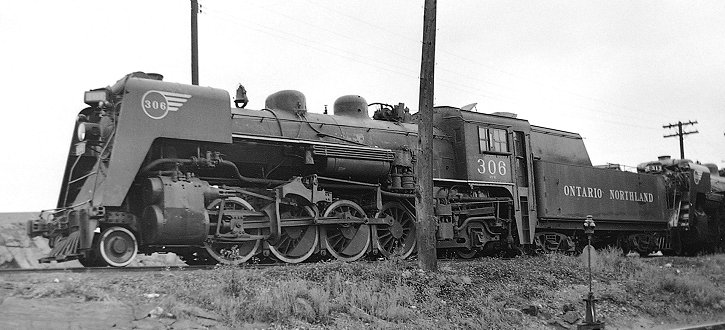
No. 306 was built in 1921 by the Canadian Locomotive Company for the Temiskaming & Northern Ontario, the name of the Ontario Northland before 1946. It is said the name was changed to avoid confusion of its initials with the Texas & New Orleans, a Southern Pacific subsidiary in the U.S. This locomotive was originally a member of the 141 class as No. 147, then was renumbered to No. 306 in the 300 class in 1929. These engines had 63-inch drivers and 25x30-inch cylinders. They carried a boiler pressure of 180 pounds per square inch and weighed 238,000 pounds. With these dimensions, their tractive effort would have been about 49,500 pounds. All ONR 2-8-2s were scrapped by 1957 when the railroad became completely dieselized.
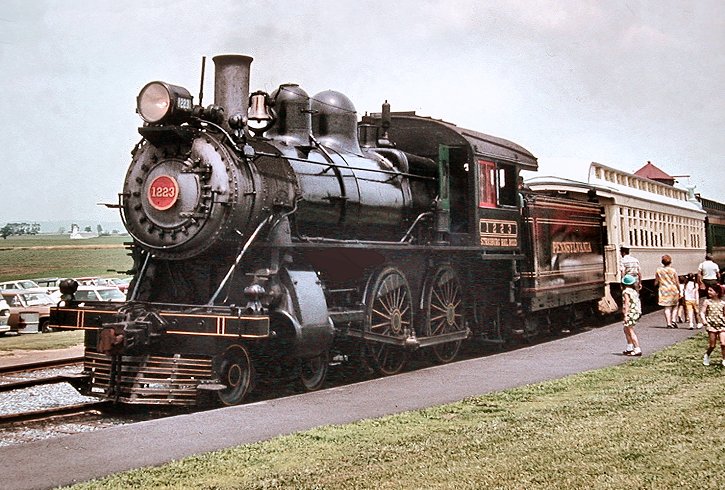
A visit to Pennsylvania's historic Lancaster County in June 1970 netted me this transparency of former Pennsylvania Railroad 4-4-0 No. 1223 in tourist service on the Strasburg Rail Road. Still owned at the time by the Penn Central Railroad (merger of the Pennsylvania and the New York Central), the locomotive was built in 1905 by the Pennsylvania's Juniata Shops. A PRR roster published in 1941 claimed that "high boiler capacity and lightweight reciprocating parts marked the construction of the D16sb class," to which this engine belonged and of which only three remained at that time. These American Standard types had 68-inch drivers, 20½x26-inch cylinders, and 175 pounds of boiler pressure. They weighed 141,100 pounds, and — as the s in the class designation indicates — they were superheated locomotives with 253 square feet of superheater surface. A typical PRR feature is the Belpaire firebox, which had a grate area of 33.23 square feet. In 1979 the Penn Central Corporation donated No. 1223 to the Railroad Museum of Pennsylvania in Strasburg where she is displayed, inoperable, today. She appears in operation, together with PRR 4-4-2 7002 (8063), in the Mark I video/DVD Doubleheader!.
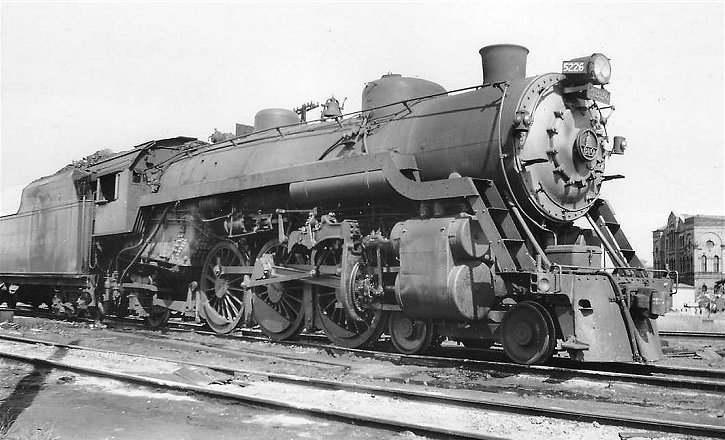
For several decades during the earlier twentieth century, the 4-6-2 or Pacific type was North America's standard locomotive for passenger service. Most major railroads used them, but some became legendary — the Pennsylvania Railroad's K-4s fleet, the Southern Railway's PS-4, and the Baltimore & Ohio's "President" series named for the first twenty-one U. S. chief executives. But the B&O had other 4-6-2s, older locomotives of lesser renown than the celebrated Presidents that nevertheless acquitted themselves nobly in their various assignments. Here we see No. 5226 posing at the Detroit servicing facilities in September 1953. A member of class P-5, she was one of ten locomotives built to the U.S.R.A. light Pacific specification and delivered by American Locomotive Company's Brooks works in 1919. They had 74-inch drivers and 22x28-inch cylinders, and sustained a boiler pressure of 210 pounds per square inch. They had an engine weight of 588,000 pounds, and exerted 40,200 pounds of tractive effort. All were retired by 1956.
The Baltimore & Ohio, although a pioneer in the use of diesel power in passenger service, retained steam in freight service a bit longer than most other eastern railroads. During 1942-1948 it even constructed new 4-8-2s for fast freight and heavy passenger duty. I remember seeing some of these engines around 1954 during a passing visit to the B&O facilities at Garrett, Indiana, a division point on the main line to Chicago. For some reason I have no photos from that encounter, but Robert Leffingwell kindly allowed me to use this transparency of 4-8-2 No. 725 (formerly 5584), taken at Barr Yard in Chicago on April 7, 1957.
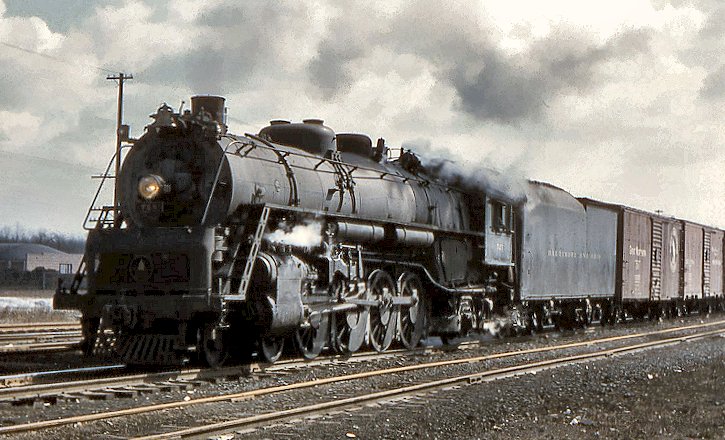
No. 725 and her sisters in the T-3 class developed a tractive effort of 65,100 pounds and weighed 375,000 pounds without tender. They had 70-inch drivers, 27x32-inch cylinders, and 230 pounds per square inch of boiler pressure, and employed the Baker valve gear. Their grate area measured 70 square feet, and they had 4010 square feet of evaporative heating surface and 1070 square feet of superheating surface. The B&O built these engines in its own Mount Clare Shops in Baltimore, using lengthened boilers from obsolete 2-8-2s and 4-6-2s.
A common sight in the 1950s was the "dead" steam locomotive — usually the victim of advancing dieselization, languishing in a storage line at a terminal or being towed to the scrap yard as part of a freight consist. More often than not, the sad estate of such engines was evident because they had their "pants down," meaning that their Walschaerts or Baker valve gear rod was no longer connected to the eccentric crank on the main driver. This allowed the driving wheels to turn freely without the resistance of cylinder compression; it was the equivalent of disconnecting the clutch or putting a car in neutral to tow it. To add insult to injury, sometimes the numbers on these locomotives were crossed out. Occasionally one sees, in web sites or even in printed books about steam locomotives, a photo of an engine with these tell-tale signs that she faces an impending rendezvous with the Grim Torcher.
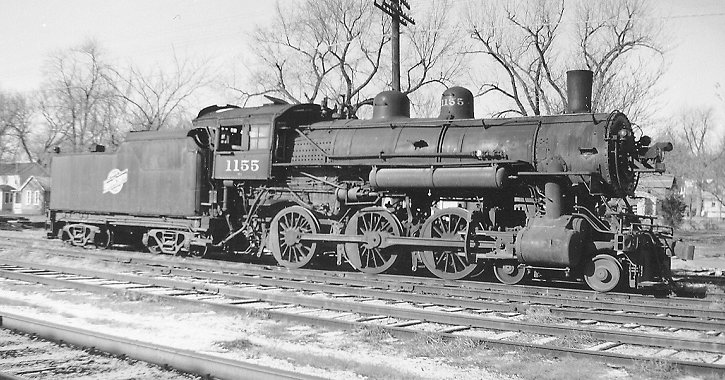
There is little, however, in this shot of Chicago & North Western Ten-Wheeler No. 1155 to betray her fearful destiny. She looks as though she could still be in service, because her Stephenson valve gear mechanism is internal, driven by a pair of offsets on the main driver axle. (Note the slanted cylinders, with the valve chamber close to the plane of the wheels.) I photographed her at Clinton, Iowa, during a Thanksgiving visit to the home of relatives in 1956.
The C&NW's class R-1 Ten-Wheelers, numbering 325 in all, were built by Baldwin Locomotive Works and the American Locomotive Company's Schenectady Works between 1901 and 1908. They had 63-inch diameter drivers and 21x26-inch cylinders, and carried 200 pounds per square inch of boiler pressure. Their locomotive weight was about 170,000 pounds and they developed 31,000 pounds of tractive effort. Many were reboilered with a grate area of 47 square feet, 1965 square feet of evaporative heating surface and 475 square feet of superheating surface, having originally been built to somewhat smaller dimensions. You can view a movie clip of No. 1155 in service at Sloan, Iowa in 1952 if you click here. The movie, also featuring some vintage automobile footage, was taken by local businessman Lawrence Duchaine and comes to our Archive courtesy of his daughter, Susan McMullen. Another member of C&NW's class R-1 4-6-0s, No. 1385 owned by the MidContinent Railway Museum, enjoyed a career in excursion service that ended in 1998 and is currently undergoing restoration efforts.
I do not recall ever having seen Soo Line steam in operation. However, early in September of 1959 my family made a trip around Lake Michigan. Passing through Gladstone, in Michigan's Upper Peninsula, we came upon several Soo Line locomotives stored out of service, in most cases with their rods intact. Among them was Mikado No. 1025, a member of class L-4. These engines were originally owned by the Monon (Chicago, Indianapolis & Louisville) and were delivered in 1912 by American Locomotive Company's Brooks Works in Dunkirk, New York. They had 28x30-inch cylinders and 63-inch drivers, and carried a boiler pressure of 170 pounds per square inch. Weighing 302,000 pounds, they developed 53,940 pounds of tractive effort. The Soo Line acquired these locomotives in 1941-42; No. 1025 was the Monon's No. 508. The photo below was taken on grainy Tri-X 35mm film, hence the poor photo quality.
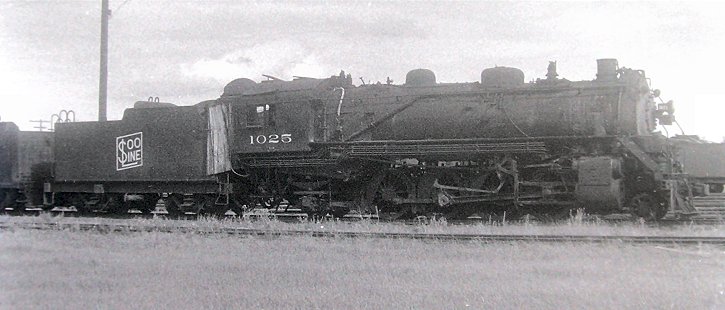
Viewer Les Beckman of the Hoosier Valley Railroad Museum in North Judson, Indiana, reports the sad story of "what might have been" with No. 1025. The Soo Line sent the locomotive through its shops to prepare it for preservation, and then the locomotive was donated to the city of Rhinelander, Wisconsin, for park display. Just before it was to be moved to its display location, Rhinelander officials mentioned to the Soo Line that they expected the railroad to maintain it. The Soo Line replied that since the engine was being given to Rhinelander, the city would be responsible for future maintenance. Regrettably, the local authorities replied "no, thanks," and a beautifully restored No. 1025 went to a scrapyard in Chicago. Sister locomotive 1024, the former Monon 504, is preserved at Thief River Falls, Minnesota.
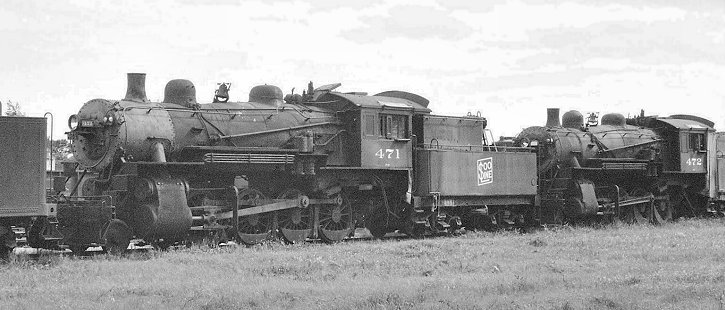
The Soo Line (Minneapolis, St. Paul & Sault Ste. Marie) and its subsidiary, the original Wisconsin Central, owned few steam locomotives built after 1923. (Exceptions were the twenty 4-8-2s and four 4-8-4s). Older power remained in service up to dieselization, including the two class F-9 Consolidations shown above, Nos. 471 and 472, in a view by my brother, David V. Leonard. Viewer Jim Nordstrom reports that he used to see them in Ashland, Wisconsin, where they were used to steam-heat ore cars in the fall and early winter. Outshopped by ALCo's Schenectady works in 1906, these engines had Stephenson valve gears but had apparently been retrofitted with piston valves driven by a linkage to the valve gear's internal rocker arm. They exerted 41,392 pounds of tractive effort and weighed 208,740 pounds. With 63-inch drivers, they sustained 200 pounds of boiler pressure and had cylinder dimensions of 22½x34 inches. Nineteen Soo Line steam locomotives survive, but these 2-8-0s were scrapped.
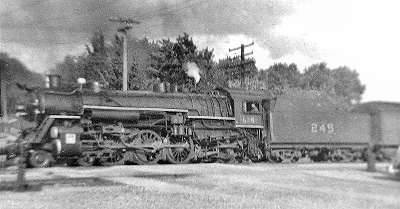 This photo of Louisville & Nashville 4-6-2 No. 245 at the head of a passenger train turned up in my father's small collection of negatives. This picture wasn't taken on my father's folding-cartridge Kodak with size 116 film, but on another camera using a smaller negative. I was born in London, Kentucky in 1938 while my father was teaching at Sue Bennett College, filling in for a professor on sabbatical leave. A main line of the L&N ran through London, and this photo could have been taken there or in nearby Corbin.
This photo of Louisville & Nashville 4-6-2 No. 245 at the head of a passenger train turned up in my father's small collection of negatives. This picture wasn't taken on my father's folding-cartridge Kodak with size 116 film, but on another camera using a smaller negative. I was born in London, Kentucky in 1938 while my father was teaching at Sue Bennett College, filling in for a professor on sabbatical leave. A main line of the L&N ran through London, and this photo could have been taken there or in nearby Corbin.
No. 245 belonged to the L&N's class K5, built by American Locomotive's Richmond works in 1919 and one of the system's heaviest Pacific types, developing a tractive effort of 42,735 pounds. These engines had 73-inch drivers and 25x28-inch cylinders. They weighed 277,000 pounds and sustained a boiler pressure of 210 pounds per square inch.
In August 1957 our family took a trip from central Illinois to Colorado and back. In those pre-Interstate days, our route took us across northern Missouri on U.S. 36. Passing through the town of Bevier we came upon the steam-operated Bevier & Southern, a 14-mile short line that hauled coal from a mine to a connection with the Burlington Route. In the ramshackle locomotive shed and on its lead tracks we found at least three Moguls (2-6-0 type), including No. 112. The sun was at the wrong angle for a decent photograph, but my brother and I both tried a shot or two; David's result was a little better than mine.
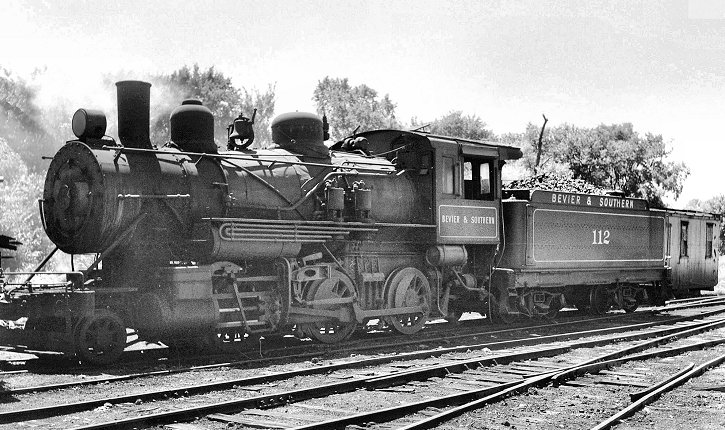
As I recall, our encounter with the B&S was a piece of serendipity. My father, brother and I had our sights set on the Colorado & Southern and Union Pacific steam we would be photographing later on, and hadn't even realized we would be passing through Bevier. But a steam engine was a steam engine, however humble, and we couldn't pass it up. No. 112 survives, on display in Bevier and recently refurbished prior to the town's sesqicentennial celebration. Below is a photo of the engine house. Both of these photos appear in Macon & Macon County Missouri Photographic History, Volume 2, compiled in 2009 by John Dennis.
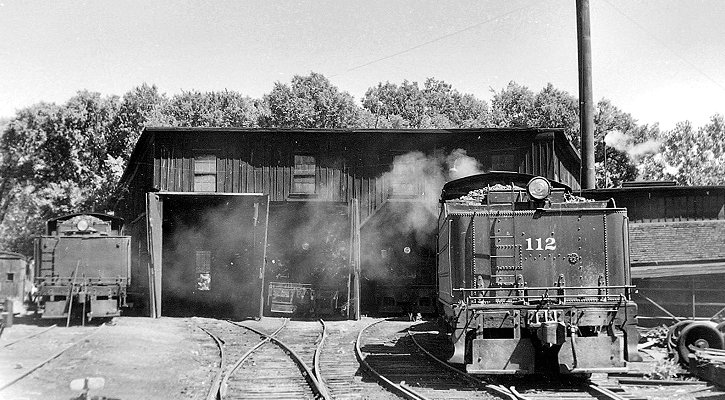
In the 1950s and 1960s the Midland Electric Coal Company operated several mines in northeast Knox County, Illinois, and also near Middle Grove at the southeast edge of the county. On a trip through the northeast Knox County area on June 10, 1961, I happened upon Midland 0-6-0 No. 85 busily at work on company-owned trackage at a location I failed to record. Coal mine trackage tends to be temporary, but research shows that Midland's northeast Knox County trackage at that time led into Stark County and a connection with the Rock Island at La Fayette.
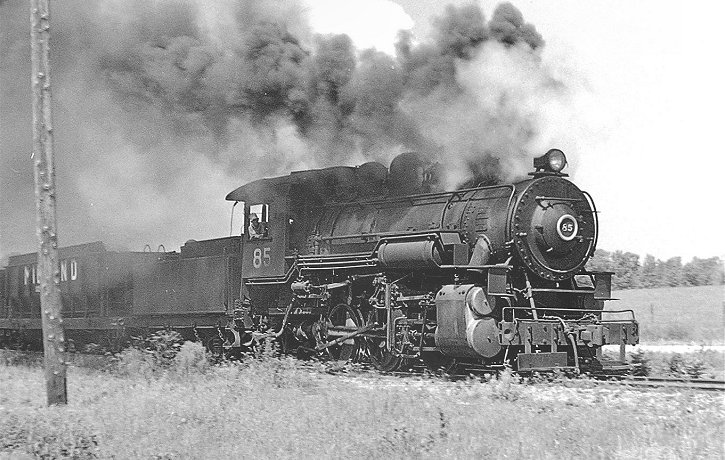
This locomotive was originally Minneapolis & St. Louis No. 85 of class B-3 (later B3-35), part of a group of seven sold to Midland in 1950. They were 1918 products of ALCo's Pittsburgh works. With 57-inch drivers and 190 pounds of boiler pressure, they developed 35,000 pounds of tractive effort. According to an article by Jim Boyd in the February 2007 issue of Railfan and Railroad, all these 0-6-0s went to the scrapper in 1964 when Midland Electric Coal was absorbed into the Peabody Coal Company. No. 85 also worked at the Middle Grove location before I snapped this photo, as Mr. Boyd's article includes a photo of it there in 1960.
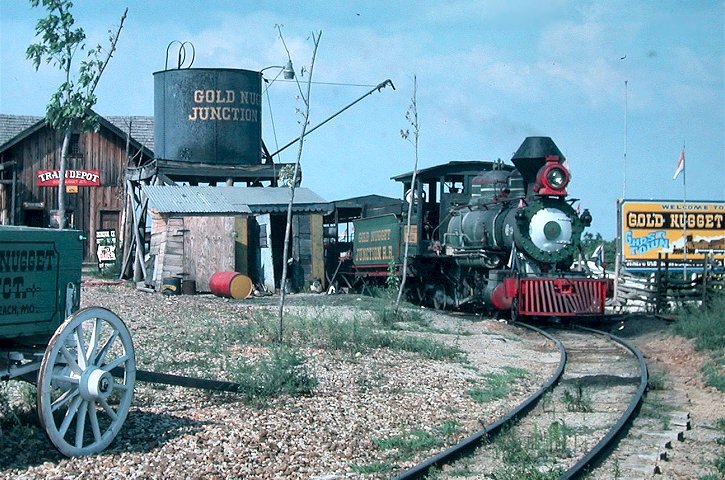
Passing through Osage Beach, Missouri in August 1975, I encountered a tourist attraction called "Gold Nugget Junction," which at that time was operating former White Pass & Yukon three-foot gauge 2-6-2 No. 4. Built by Baldwin Locomotive Works in 1912 for the Klondike Mines Railway, she was acquired by the WP&Y in 1942 for use as a switcher. In 1955 she was sold and operated on a tourist line in Wisconsin before going to another tourist railroad near Sevierville, Tennessee that closed in 1965 after only a few days of operation. No. 4 came to Gold Nugget Junction, in the Missouri Ozarks, in 1969. I have not been able to determine how long Gold Nugget Junction operated after I photographed the locomotive in 1975, but eventually No. 4 became inoperable and was put on static display. In 1984 the engine was sold to the owner of the Midwest Central in Iowa, but was immediately resold and moved to Oklahoma instead. After being for sale for several years at Dry Gulch, USA near Tulsa, she is operational today at the South Park Rail Society in Como, Colorado.
In 1945-1947 the Reading Railroad (later absorbed into Conrail) built thirty class T-1 4-8-4s in its own Reading Shops, some with boilers lengthened from obsolete 2-8-0s. Nos. 2100-2129, intended for freight service, had 70-inch drivers, 27x32-inch cylinders, 240 pounds per square inch of boiler pressure, and a locomotive weight of 441,300 pounds. They exerted 68,000 pounds of tractive effort, which was augmented to 79,100 pounds with the booster operating. Their wide firebox was typical of the Reading's locomotives. Originally it enabled them to use the cleaner-burning anthracite coal mined in eastern Pennsylvania, but by the time the T-1s were built the Reading's locomotives were burning regular bituminous coal.
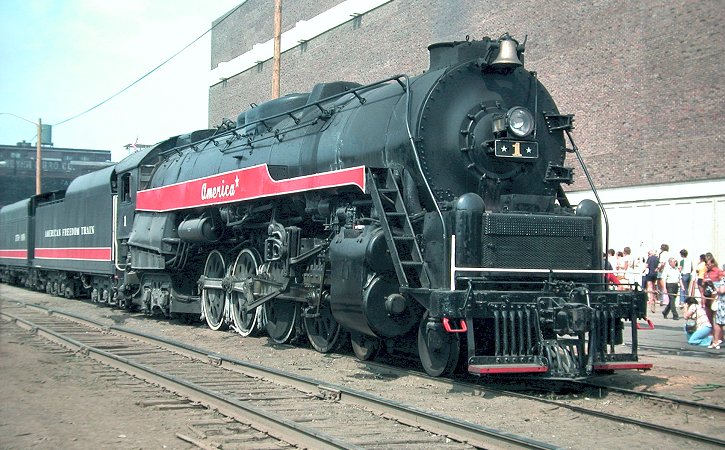
Four of these outstanding engines (2100-2102, 2124) escaped the scrap yard and remain today. In 1975 No. 2101 was tapped as one of three steam locomotives to haul the American Freedom Train across the nation. The train, featuring historical displays in honor of the bicentennial of the United States, made stops in many American cities. Owner Ross Rowland renumbered the locomotive to No. 1 because of his conviction that "thanks to 200 years of participatory democracy America had grown into the #1 nation in the world." No. 2101 was featured on the cover of the Official Commemorative Program.
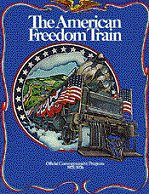
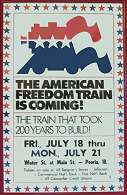 Thus it came about that on a fine July day in 1975 my wife and I and our children joined my parents for a picnic lunch in the Peoria, Illinois, area and a visit to the Freedom Train. There I took this color transparency of No. 2101, temporarily renumbered and in patriotic livery for this special duty. A year or two later we would see her again, quite unexpectedly, on a Chessie Steam Special in Indiana, while returning from a visit to relatives in Ohio. In the early 1980s No. 2101 was heavily damaged in a roundhouse fire in Kentucky; cosmetically restored, she resides today at the B&O Railroad Museum in Baltimore. Sister 2102 is stored at the Reading & Northern Railroad in Port Clinton, Pennsylvania, while 2124 is inoperable at Steamtown. And No. 2100, after an unsuccessful attempt in Canada to convert it into an oil-burner, was moved to the Golden Pacific Railroad operation in Tacoma, Washington but is now undergoing restoration in Cleveland, Ohio by the American Steam Railroad Preservation Association. For another view of No. 2101 and the Freedom Train taken by my brother, included in our Random Steam Photo Collection, click here.
Thus it came about that on a fine July day in 1975 my wife and I and our children joined my parents for a picnic lunch in the Peoria, Illinois, area and a visit to the Freedom Train. There I took this color transparency of No. 2101, temporarily renumbered and in patriotic livery for this special duty. A year or two later we would see her again, quite unexpectedly, on a Chessie Steam Special in Indiana, while returning from a visit to relatives in Ohio. In the early 1980s No. 2101 was heavily damaged in a roundhouse fire in Kentucky; cosmetically restored, she resides today at the B&O Railroad Museum in Baltimore. Sister 2102 is stored at the Reading & Northern Railroad in Port Clinton, Pennsylvania, while 2124 is inoperable at Steamtown. And No. 2100, after an unsuccessful attempt in Canada to convert it into an oil-burner, was moved to the Golden Pacific Railroad operation in Tacoma, Washington but is now undergoing restoration in Cleveland, Ohio by the American Steam Railroad Preservation Association. For another view of No. 2101 and the Freedom Train taken by my brother, included in our Random Steam Photo Collection, click here.
After a hiatus of almost two decades while I was living at some distance from my parents due to school and employment, it was good, on that summer day in 1975, once again to be steam-viewing with my father. It was to be our last such occasion. The following year, after preaching a sermon, my father suffered a stroke in church and passed away within the week. "What a way to go!" commented a colleague at his memorial service. But I think Dad might just as soon have gone to his reward while watching trains.
